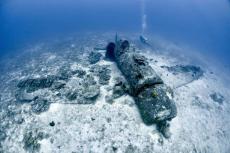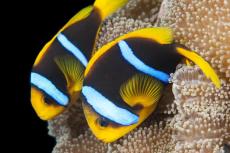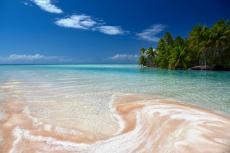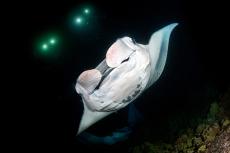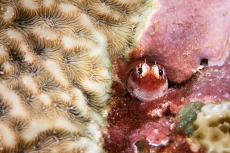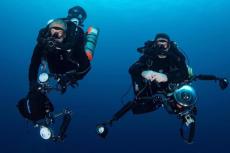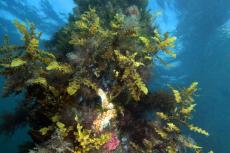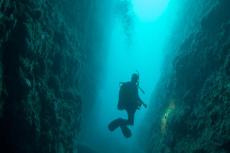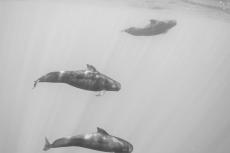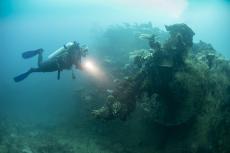Vanuatu: A Dive with a Living Fossil at Penama Island
A look at one of nature’s oldest living and least understood marine invertebrates, the chambered nautilus. Look up a chambered nautilus in a book or on the web will reveal they are in the same class of mollusks as octopuses, squid and cuttlefish. The first thing that sets this cephalopod apart from the rest of the group is that the nautilus date back more than 500 million years, and were once the dominant form of life in the ocean. And to share a night dive with one of these true living fossils is a very fortunate event.
Look up a chambered nautilus in a book or on the web will reveal they are in the same class of mollusks as octopuses, squid and cuttlefish. The first thing that sets this cephalopod apart from the rest of the group is that the nautilus date back more than 500 million years, and were once the dominant form of life in the ocean. And to share a night dive with one of these true living fossils is a very fortunate event.
Aug. 14, 1992, Penama Island, Vanuatu: It was well into the night, and black as pitch. We could actually see the stars through the clear waters overhead, and our dive lights seemed insignificant against the steep drop off below. The location was the eastern end of Penama Island in the central region of the Vanuatu island chain.
We didn't mind the dark, and in fact had planned it that way, purposely selecting a night during a new moon phase to further increase our chances of finding one of the ocean's oldest living cephalopods, the chambered nautilus.
Our quest didn’t take long, less than eight minutes into the dive; we spotted our first individual just below the crest of the wall at depth of 60 feet. Less the minute later, two more are found around the same depth.
Watching one swim, using its syphon as their primary means of locomotion seems clunky and ungainly, having a somewhat bobbing, start-stop motion further than a fluid one a squid, or even octopus.

Over the eons, other cephalopods transformed their armoring shells into internal beaks, and became masters of camouflage, concealment and evasion. The nautilus, meanwhile, kept its protective hard shell and has remained virtually unchanged for the past 450 million years. They also grew more tentacles. Rather than the eight to 12 found on their soft-bodied cousins, they have up too 90. But, it is that trademark shell that makes this animal really special as it represents one of the finest natural examples of a logarithmic spiral as well as remarkably resistant to imploding under pressure to depths of 2,600 ft/800 m.
If you where to view a cross section of a chambered nautilus shell, you would find the shell is divided internally into camerae (chambers), hence the name. These chambered sections, called the phragmocone, are defined by the presence of thin wall or septa, each of which is pierced in the middle by a duct called a siphuncle.

At birth, a baby nautilus starts off with around four of these camerae, developing new, additional chambers as it matures moving its growing body into the larger space, at the same time sealing the vacated chamber with a new septum. By the time a nautilus reaches full maturity the total number of camerae to thirty or more.
Although the animal can withdraw completely into its shell and close the opening with a leathery hood for protection from predators, the compartments within the shell also act as sort of passive flotation device comparable to the swim bladder in bony fish, allowing them to swim with the minimum effort. In their geologic past, some varieties of these cephalopods grew to an enormous size (over ten meters in length) due to this one specialty.

Outside the shell, the eyes of the nautilus are quite striking in appearance, but when comes to functionality, they don't work well, as they have no lenses. For hunting, this animal relies much more on a pair of rhinophores like those found on nudibranchs, which detect chemical changes in the water to help find food in the dark.
And it is in the dark where the two surviving genera - the chambered nautilus (Nautilus pompilius) and its smaller Palauan nautilus (Nautilus suluensis) - spend their time. They live in deep costal waters of the Indo-Pacific, spending the daylight hours at depths of 1,000 - 1,600 ft/300 - 500 m, then rising to hunt on coral reefs during the night.
Fishermen have learned to capture nautilus by setting traps at depths from 160 - 320 ft/50 to 100 m. This is usually done to harvest the shells for ornamental sale, but on the deep drop offs in Palau, Papua New Guinea, and Northern Solomon Islands, it's also done to provide photographers with a subject.
One might think that catching and releasing an animal after a photo op is better than killing it for the shell. But in reality, the sudden depth change, combined with exposure to bright sun light and warmer water temps (nautiluses generally avoid water temperatures above 25°C) places a serious stress on the animal, and many don't survive the release.
Between this practice and more commercial harvesting, there is growing concern that this 500 million survivor my no go much further. Fishery biologist are beginning to see an alarming decline populations of nautilus in all the regions they are known to be found as a result of overfishing. Not just for their shells for the tourist and shell collectors but also for the nacreous inner layer of the shell, which is used as a pearl substitute in cosmetics. This new level of pressure has triggered scientific groups to investigate world populations to determine if there is a need for protection under the United Nations Convention on International Trade in Endangered Species.
The one place where it's possible to photograph or observe a chambered nautilus without doing harm is in the Southern Melanesian Island Group, between New Caledonia and Vanuatu. Here, chambered nautiluses can be found at night to depths as shallow as 16 ft/5 m.
The reason for these shallow-water appearances is not known, though some scientists speculate that it is because the surface water temperatures in these southern hemisphere habitats are cooler than in equatorial habitats. One thing is certain, make a night dive the edge of a reef with a deep drop off to 330 ft/100 m plus, as I have done off the reefs in around the island of Espiritu Santo in Vanuatu, with little to no moon, and you are almost assured of success.
As the night went on, we continued to find them shallower and shallower, to the point of seeing them on top reef shelf in as little as 16 ft/4.8 m of water.
Photo Tip:
Because nautiluses are highly light sensitive, I would advise limiting dive light use to quick, periodic sweeps when hunting. In regards to care 7 handling, once a nautilus is found, make your photo encounter brief to avoid stressing the animal too far, perhaps three or four shots before moving on to the next Nautilus. When there is one, there are often several more in the area.

All photos taken (August 1992) in Vanuatu with Nikon F4 and Nikon 60mm macro f.2.8 lens. Lighting provided by two Sea & Sea YS-200 strobes set at half power with camera settings 1/60 sec. and aperture values at f11 to f16 with Kodachrome 25asa transparency film.
- Log in to post comments


